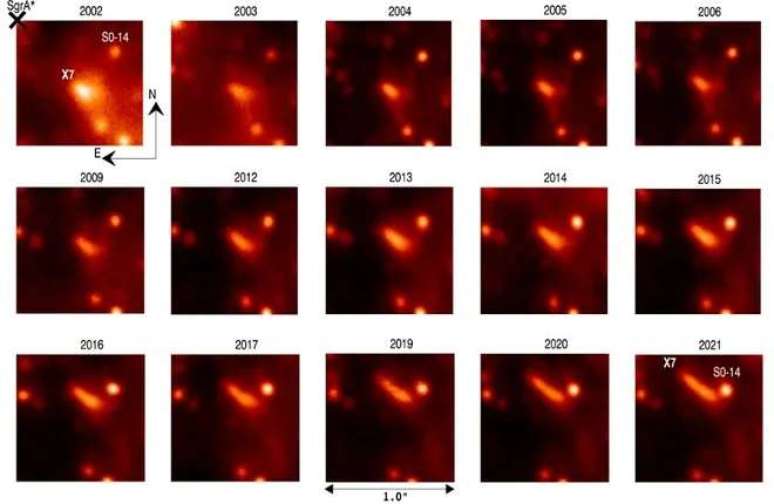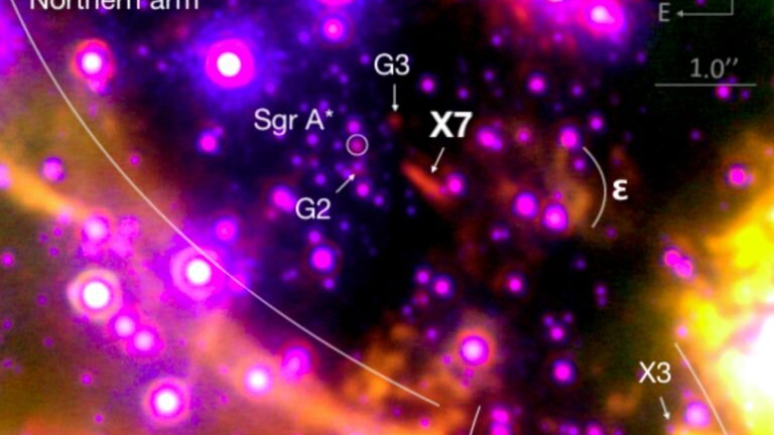The researchers monitored cloud X7, which is undergoing a process of disintegration as it accelerates towards the Milky Way’s supermassive black hole.
After 20 years of observations, astronomers have managed to reveal the passages that the peculiar cloud X7 went through as it breaks apart as it accelerates towards Sagittarius A*, the supermassive black hole 26,000 light years from us, in the heart of the Milky Way. They worked with the WM Keck Observatory in Hawaii.
- 10 answers to questions you may have about black holes
- The possible black hole is closer to the Sun than any other known
The X7 cloud is about 50 times the mass of the Earth, and researchers have been following its evolution since 2002. Using the observatory’s high-resolution infrared images, they found that the cloud had become so elongated that it now spans 3,000 times the distance between the Earth and the Sun.

The stretch is the result of the gravitational tidal forces of Sergeant A*, a Black hole 4.3 million solar masses. Because it’s so massive, its gravity affects objects that get too close: The side of the cloud that’s closest to the black hole ends up being distorted by gravity and is more “stretched” than the one farther away. This process is known as “spaghettitification”.
“It is exciting to see significant changes in the shape and dynamics of the X7 in such detail in a relatively short period of time, as the gravitational forces of the supermassive black hole continue to influence the object,” added Randy Campbell, co-author of the study.
It currently takes 170 years for the cloud to orbit the black hole, but it may not even have time to complete one orbit. “We predict that strong gravitational tidal forces exerted by the galactic black hole will break X7 apart before it completes a single orbit,” noted co-author Mark Morris.
According to the authors, the X7 cloud will make its closest approach to Sgr A* around 2036, and should end up dissipating soon after; the gas and dust of its structure will eventually be swallowed by the black hole, and it could also offer light emissions by heating up during the object’s approach.
The following animation represents this process:
The discoveries represent the first estimate of X7’s orbit and are also the most robust analyzes of its appearance, shape and behavior ever done. It has some of the same observational properties as other objects orbiting the Sun. milky way black hole, but its origin is still unknown. Now, the team will continue to monitor changes in the cloud as the black hole feeds on it.
The article with the results of the study was published in the journal The Astrophysics Journal.
Source: Astrophysical Journal; Through: WM Keck Observatory
Trending on Canaltech:
- 10 TV Shows That Went Wrong After Season 1
- Irpef 2023: discover the new exemption band
- What is the toughest cell phone in the world?
- Galaxy S23 Ultra vs iPhone 14 Pro Max: Which is better?
- Extremely rare case: child born with a 6 cm tail in Brazil
- FGT | Figure out what should change in the anniversary retreat
Source: Terra
Rose James is a Gossipify movie and series reviewer known for her in-depth analysis and unique perspective on the latest releases. With a background in film studies, she provides engaging and informative reviews, and keeps readers up to date with industry trends and emerging talents.



![Plus Belle La Vie Adher: That’s what you expect on Tuesday, July 22, Tuesday, July 22, 381 episode [SPOILERS] Plus Belle La Vie Adher: That’s what you expect on Tuesday, July 22, Tuesday, July 22, 381 episode [SPOILERS]](https://fr.web.img4.acsta.net/img/08/3f/083f99a673a3911098f530af30a36af3.jpg)


